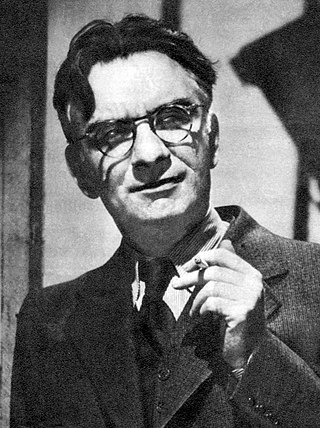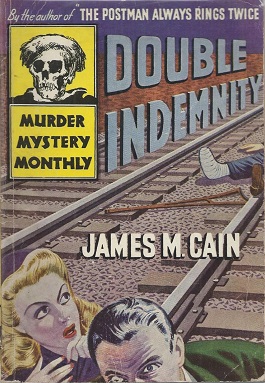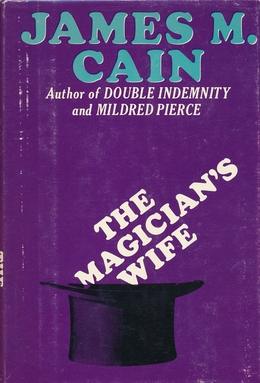Publication history
Following his enormously successful romance-crime novel The Postman Always Rings Twice in 1934, Cain sought to capitalize on the notoriety of the book by quickly writing serials for popular literary journals. With Liberty, Redbook and Collier's clamoring for more "commercial stories", Cain was less concerned with literary merit, and more with financial rewards. [9] Despite this the stories included in Three of a Kind are representative of Cain’s best literary output, in formed by the later years of the Great Depression. [10] [11] Cain acknowledged as much when he wrote in 1943 "These novels, thought written fairly recently, really belong to the depression, rather than the war, and make interesting footnotes to that [earlier] era." [12]
In a 1943 Time magazine review of Three of a Kind, a critic noted "the rancid air of authenticity which Cain obtains by screwing down his competent microscope on a drop of that social seepage which discharges daily into U. S. tabloids and criminal courts." [13] [14] Cain himself initially had a low opinion of Double Indemnity. [15] In his preface to Three of a Kind, Cain complained that "I am probably the most misread, misreviewed and misunderstood novelist now writing…[I’ve made] no conscious effort to be tough, hard-boiled, grim, or any of the things I am usually called…" [16] [17]
In 1949, the American Library Association included Three of the Kind as among the most popular library books of the past 25 years, the only work of Cain’s ourve to be honored in the collection. [18]
Film adaptations
When Three of a Kind appeared in print, Career in C Major and The Embezzler had already been purchased by film studios: Career in C Major was filmed in 1939 as Wife, Husband and Friend and in 1949 as Everybody Does It , both for 20th Century Studios.
Warner Brothers released its film adaptation of The Embezzler under its original serial title, Money and the Woman in 1940. [19] Only Double Indemnity had not yet been obtained for film adaptation. All the major studios had rejected the scenario, a "blueprint for murder" concerning an adulterous pair who execute a cold-blooded killing for profit. Even Cain conceded it was "the most censorable story, if any story is censorable, that I ever wrote." [20] When Cain’s agent, Harold Norling Swanson, promoted Three of a Kind throughout the Hollywood establishment, Austrian-American film director-producer Billy Wilder insisted that Paramount Studios acquire the rights. Wilder made a highly regarded adaptation of the work under the same title in 1944. Detective fiction novelist Raymond Chandler co-wrote the script. [21] [22]
Cain’s fame as literary figure is closely linked to the film adaption of Double Indemnity, as well as his Mildred Pierce and The Postman Always Rings Twice, each "credited with having had a significant impact on Hollywood’s approach to films." [23] Double Indemnity was republished in a collection of Cain novels entitled Cain X 3 in 1968. The collection revived interest in Cain and his reputation as a writer of "American classics". [24] [25] [26]

Mildred Pierce is a psychological drama by James M. Cain published by Alfred A. Knopf in 1941.

James Mallahan Cain was an American novelist, journalist and screenwriter. He is widely regarded as a progenitor of the hardboiled school of American crime fiction.

The Postman Always Rings Twice is a 1934 crime novel by American writer James M. Cain. The novel was successful and notorious upon publication. It is considered one of the most outstanding crime novels of the 20th century. The novel's mix of sexuality and violence was startling in its time and caused it to be banned in Boston.

Double Indemnity is a 1943 crime novel by American journalist-turned-novelist James M. Cain. It was first published in serial form in Liberty magazine in 1936 and later republished as one of "three long short tales" in the collection Three of a Kind.
Career in C Major is an opera-themed novella by American writer James M. Cain, first published in 1938. First appearing as a serial in The American Magazine entitled "Two Can Sing", this comic romance is a departure from Cain's first novels, Postman Always Rings Twice (1934) and Double Indemnity (1936), both hardboiled crime stories that included premeditated murder. Redbook magazine, disappointed that Cain had exchanged his hard-boiled themes involving sex and murder for a "comedic adventure", declined to purchase the novella but Liberty obtained the piece and carried it as a serial in 1935.

Serenade is a novel by James M. Cain published in 1938 by Alfred A. Knopf. and one of four Cain novels to feature opera as a plot device. Loosely based on Bizet's Carmen, the story explores the sources of artistic development, in particular the role played by sexual orientation in the development of artistic talent.
The Embezzler is a 1938 short novel by James M. Cain. The work first appeared as a serial in Liberty magazine in 1940 under the title Money and the Woman. In 1943, Alfred A. Knopf published the work as The Embezzler in a collection of novellas by Cain entitled Three of a Kind.

Love's Lovely Counterfeit is a hard-boiled short novel by James M. Cain published by Alfred A. Knopf in 1942. The story is set in a Midwestern town where rival gangsters struggle to maintain control of their criminal enterprises. The work is one of only three of Cain's novels told from the third-person point-of-view.

The Butterfly is a hard-boiled novel by author James M. Cain published by Alfred A. Knopf in 1947. The story is set in rural West Virginia in the late 1930s and concerns a mystery surrounding an apparent case of father and daughter incest.

Our Government is a collection of satirical dialogues and sketches by James M. Cain published in 1930 by Alfred A. Knopf as part of The American Scene series. Our Government is the first of Cain's many books.
7-11 is a play by James M. Cain staged in August 1937 on Cape Cod produced by Richard Aldrich and directed by Alexander Dean.

Sinful Woman is a detective novel by James M. Cain that appeared originally as a paperback in 1947 by Avon publishers. Sinful Woman was the most commercially successful of three paperbacks Cain wrote for Avon in the late 1940s and early 1950s.

Galatea is a romance novel by James M. Cain published by Alfred A. Knopf in 1953. The story alludes to the mythological Galatea in which the sculptor Pygmalion falls in love with the ivory figure of a woman he has crafted. In Cain’s modernized version of the Greek legend, an overweight woman is transfigured through a program of weight reduction into a goddess-like beauty.

The Root of His Evil is a novel by James M. Cain published in paperback by Avon in 1951.

The Moth is a novel by James M. Cain published in 1948 by Alfred A. Knopf. The work is the last of Cain’s four novels to feature opera as a central element of the story; the others are Serenade (1937), Mildred Pierce (1941) and Career in C Major (1943) At over three-hundred pages, The Moth is Cain’s “most personal, most ambitious and longest book” in his oeuvre, attempting to convey a “broad, social landscape” of America in the 1930s.

Mignon is a historical novel by James M. Cain published by the Dial Press in 1962. Along with Past All Dishonor (1946), Mignon is one of Cain’s two historical novels set during the American Civil War.

The Magician's Wife is a novel by James M. Cain published in 1965 by Dial Press.

Cain X 3 is a collection of three previously published novels by James M. Cain, reissued in 1969 by Alfred A. Knopf, with an introduction by Tom Wolfe.

The Institute is a novel by James M. Cain published in 1976 by Mason-Charter. The Institute is a story of academia and high finance set in the community of College Park, Maryland concerning members of the Washington, D. C. political establishment.

Jealous Woman is a mystery novel by James M. Cain published in 1950 by Avon.
This page is based on this
Wikipedia article Text is available under the
CC BY-SA 4.0 license; additional terms may apply.
Images, videos and audio are available under their respective licenses.
















